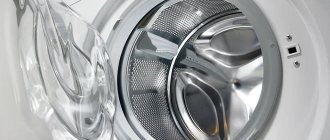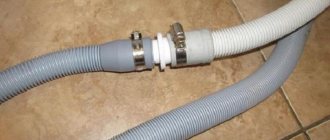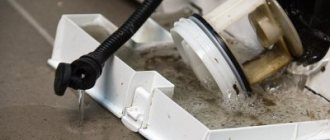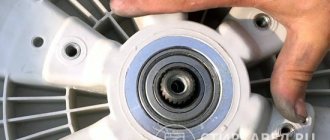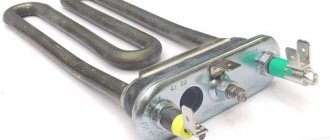During the operation of a washing machine (WMA), parts and mechanisms age and break down. Under the influence of hot water and the chemically active powders used, scale deposits on the walls of the hoses, which leads to the formation of cracks and a decrease in strength. This threatens the formation of fistulas, the pouring of water in addition to the sewer into the room and its contact with live equipment. To eliminate the defect, you need to install a new part. Replacing the drain hose of a washing machine yourself is not difficult, and the amount of work depends on the brand of the unit.
Types and features of drain hoses
The product is a light-colored polypropylene hose with rubber fittings of various diameters (from 18 to 22 mm) at both ends. Its main function is to drain liquid into the sewer during operation. Depending on the length and function, there are 3 types of drain hoses. These include:
- Regular drain hose. It has a fixed size (from 1 to 5 meters). If it is necessary to increase the length, connect the two products using two clamps and an extension.
- Telescopic universal hose. Initially, the compressed size of the device is about 60 cm. In working condition, the device stretches up to two meters. The main disadvantage of the product is its susceptibility to blockages and strong vibration due to the corrugation of the hose.
- Coil-shaped hose. It is a product on which notches are applied, allowing you to measure the required length and shorten the module (0.5 m). If you use a hose that is too long, this will lead to clogging, stagnation and, in the future, breakdown of the machine. Therefore, it is recommended to cut the module to the optimal size.
Different models of washing machines have different locations and fastenings of the drain hose. However, there are general troubleshooting steps that are recommended to be performed regardless of the brand.
To begin correcting a problem with the product, drain the liquid from the washing unit. To do this, you will need to remove the lid at the bottom, unscrew the drain filter and release the water.
Location of the drain hose base at the rear
This option is used by the following home appliance manufacturers: Indesit, Lg, Samsung, Beko, Candy, Ardo, Whirpool, Ariston. Once the panel has been removed (as described above), follow these steps to install a new drain hose:
- Take a photo of the clamp attachment to ensure proper installation of the new product.
- Loosen the clamp and completely unfasten the part.
- Slowly remove the old hose and secure the new product using the photo.
- Reassemble the parts in reverse order.
- After connecting the free end to the drainage system, check the tightness of the connection.
What to do if water is constantly collecting?
If your Samsung machine continuously pumps water into the system, but the drain hose does not remove it, you need to look for the reason in the pressure switch; most likely, the inlet valve has failed. As a rule, this is preceded by certain reasons:
- the membrane weakens;
- the element completely loses its ability to work normally.
When the drain element is cleaned or replaced, but the malfunction is not eliminated, the device is diagnosed using special equipment.
Location of the drain hose base on the front panel
This option is used by such manufacturers of home appliances as Bosch, Siemens. To replace the drain hose of the washing machine, remove the front plastic surface. To do this, move the bottom panel to a distance of about 5-6 cm and unfasten the connector with wires from the module locking device. Then we slide the panel towards us and set it aside.
When access to the drain hose is open, remove the part by loosening the clamp and removing the fixing elements with a screwdriver. We replace the part of the machine with a new one, performing the steps in the opposite order. At the end, do not forget to check the tightness of the connection of the parts to the pump, and whether there are any kinks in the hose.
We change the hose for AEG, Siemens and Bosch machines
Let's take a closer look at the entire replacement process:
- First, remove the dispenser container.
- Then we will remove the base panel.
- Loosen and remove the clamp that secures the rubber seal of the door. After this, detach the cuff from the front wall of the case.
- Remove the drain pump filter and drain the water into a pre-prepared low container.
- We twist the screws that hold the front part of the machine.
- We pull the bottom of the wall in our direction a couple of centimeters, then move it lower and gently pull it towards ourselves. You need to make sure that a gap of about 5 centimeters is formed.
- From the inside you need to feel for the hatch locking device. It is located where the lock hook fits into the hole when the door is closed. It is necessary to disconnect the connector with wires from this device.
Now let's start replacing the hose
- By removing the front wall, you have access to the hose. Now you can remove the elements securing it and disconnect it from the pump.
- After this, remember or take a photo of the location and fastenings of the hose.
- Disconnect the hose and take it out.
- We stretch and connect the new hose to the pump and fasteners.
- We assemble the machine.
- Check the tightness of the connections.
When does the drain hose need to be replaced?
The drain hose serves to drain waste water, so it is attached to the drain pump, next to the pipe. It is made of polypropylene, so it can withstand water of different temperatures and also remains resistant to chemicals.
For what reasons does he need a replacement?
- Inappropriate element. Often, when you purchase a washing machine, you receive a hose included. However, it may be short during installation. Of course, you can lengthen the element, but this increases the risk of water leakage.
- Mechanical damage. Replacing the washing machine drain hose may be necessary if there is a fracture or a leak. It is recommended to replace the part immediately.
- The hose is so clogged with debris and scale that it needs to be replaced.
Why change it?
The drain hose in the washing machine is necessary to drain the used water. It is located next to the pipe and extends from the drain pump, which in turn ensures the flow of liquid into the hose. As a rule, it is made from polypropylene. This material allows it to remain resistant to high water temperatures and aggressive detergents. But, despite its high strength, replacing the hose on a Samsung machine becomes necessary over time. Let's look at the main reasons that require installing a new pipe.
- Lost connection. The washing machine comes with a standard length hose. Often, to lengthen it, the owner builds it up. Most often, a break occurs at the junction.
- Damage. Possible mechanical impact on the part leads to rupture of the material. Water is leaking. Replacement is urgently needed.
- Congestion. Over time, scale accumulates on the inner walls of the hose, residues of washing powder stick, and water can no longer pass through the pipe.
Possible problems and ways to solve them
Expert advice will help you effectively deal with the problem:
- A leak is not always a sign of a broken hose. It is necessary to carefully inspect the entire length of the hose to try to find the location of the break. Leakage can also be caused by wear of other parts.
- Ignoring even a small leak can lead to big problems, including flooding downstairs neighbors, damage to the floor, and serious damage to the washing machine itself. If there is a leak, the problem will only get worse, so it needs to be addressed immediately.
- Lack of skills in repairing equipment is a reason to seek help from a specialist. Inept actions can cause harm.
- When bringing the washing machine indoors from the cold, you need to wait for several hours. Since the remaining water that was in the car and turned into ice can cause serious damage.
- If the length of the factory hose is not enough, it is recommended not to extend it, but to replace it with a new one of the required size. The connection point will not have the required reliability.
You should not leave a running washing machine unattended, as an emergency situation may arise, such as a leak.
Replacing the washing machine drain hose yourself
Household appliance manufacturers produce many different models of washing machines.
They differ in technical characteristics, capabilities, the presence of additional functions, and appearance. Despite these differences, their main task is washing clothes, which requires adding and draining water. Water enters and leaves the machine using hoses. During operation, the drain hose of the washing machine may become damaged and will need to be replaced. This operation is not particularly difficult to perform, so you can do it yourself, taking a little time.
Depending on the model of the washing machine, the location and fastening of the drain hose differs. But there are a number of general actions that need to be done regardless of the model.
Before proceeding with the replacement, you need to disconnect the machine from communications - electricity and water supply.
Preparing for replacement
Replacing a drain hose is a slightly more labor-intensive process compared to replacing a fill hose. To replace the drain, you need to disassemble the washing machine and disconnect it from the pump. Depending on the manufacturer of the machine, the hose inside can be routed and secured in different ways. To make it more convenient to work, you can first dismantle the top cover of the machine. This is done as follows:
- unscrew the screws holding the lid - they are located on the back wall of the machine;
- Having unscrewed the screws, the cover must be moved back so that it comes out of the grooves;
- remove and set the cover aside.
Further actions depend on the specific brand of equipment. There are several common options for accessing the drain hose, which are similar for certain manufacturers due to the design features of the machine models.
How to get to the drain hose
That is why, to replace the machine hose, you need to disconnect the hose from the drain pump, and only then from the body of your washing unit itself.
To make it more convenient for you, you can disconnect the top hatch of the machine.
Let's look at several options for gaining access to the drain hose connection, based on the individual characteristics of each design from various groups and subgroups.
Replacing the drain hose of Electrolux and Zanussi washing machines
In washing designs from Electrolux and Zanussi, access to the elements inside is achieved by opening the back wall of the panel, since the bottom is almost impossible to open, and the front panel does not open at all.
How to remove the back cover
- Remove the outer cover of the washing device. To do this, unscrew the 2 fastening screws from the rear panel, move the cover back and disconnect it.
- Next, you should start unscrewing the screws on top and a couple on the sides (they can be found under the plugs), and two or three on the bottom.
- Separate the plastic fastenings of the intake valve from the rear panel and carefully disconnect the rear wall.
How to remove and install a drain hose
- After dismantling the back panel, we gained access to all elements. Now you need to drain the remaining water through the drain hose. To do this, lower it as low as possible and place some kind of cup and rag in advance for backup.
- Next, we look for the fastening of our hose and disconnect it by loosening the clamp.
- We disconnect the hose from the body, first remembering the location.
- We attach the new part in place of the old one and secure it with a clamp.
- We connect the free end to the sewer and check the level of tightness.
- We assemble the back panel in descending order of all the steps described above.
Changing the drain hose in an AEG, Bosch and Siemens washing machine
In these cases, you can get an inlet to the drain hose fastener for washing units of this group through the front panel.
How to remove the front panel
- Release the clamp and carefully disconnect the hatch cuff from the front panel of the washing machine body.
- Remove the dispenser.
- Detach the decorative panel at the very bottom.
- Pour the remaining water through the pump filter element, after placing a rag under it.
- Unscrew the screws securing the front panel to the device body. One bolt will be at the top and 2 at the bottom.
- Move the lower part of the socket slightly towards you, then move it down and disconnect the entire socket by about 5-8 cm.
- Disconnect the cords from the blocking holes that are located on the wall.
How to remove and install a drain hose
- When you finally have access to the interior of your washing machine, remove the drain hose clamp and disconnect the hose from the drain structure.
- Insert the new hose tightly in place of the old part, and clamp it all with a clamp.
- Next, we run the hose along the walls, attach it to the shell of the device and bring it outside.
- Connect the end of the hose (outlet) to the sewer and check your installed part for tight connections.
Changing the drain hose in washing machines Ariston, Indesit, Samsung, Ardo, VEKO, LG, Sandy and Whirpool
In washing units of this group, access to the hose, or rather its fastening, can be found through the bottom of the structure.
- Disconnect the lowest socket that secures the pump filter.
- Pour out the remaining water, taking great care to unscrew the filter.
- Pull the washing machine forward, and when you tilt it back, place it against the wall.
- Starting work at the bottom of the device, unscrew all the screws securing the snail, remove it from the body and lower it.
- Once you have access to the drain hose, disconnect it from the drain system, first loosening the clamp using pliers.
- Try to remember the location of your old drain hose in the middle of the body, and then disconnect it and remove it. For convenience in this type of dismantling, we recommend removing the outer cover of the structure.
- Connect the newly purchased hose and reassemble the machine in reverse order.
- Connect the hose to the sewer and check the tightness of the drain hose connections on both sides.
The drain pump has failed
During operation of the unit, a situation may arise that the liquid does not drain from the tank. Then you will need to replace the drain pump.
To do this, you don’t even need to remove the plastic panel of the washing machine, since the pump is changed from the bottom (for brands such as Samsung, Indesit, LG washing machine and others). The operating algorithm is as follows:
- Turn off the power to the unit and close the water tap.
- Lay down the fabric and place the machine on it. In this case, there should be a drain pump on top.
- Using a screwdriver, unscrew the screws and remove the pump.
- We press on the drain pump and take it out.
- Disconnect the wires going to the pump. To do this, simply remove the spare part from the pump.
- We drain the remaining liquid into a container prepared in advance by loosening the clamps and disconnecting the drain hose with the pipe.
- We install the new pump in the washing machine, performing the steps in the reverse order, securing it with bolts or snapping it onto the fasteners (for example, in some Samsung models).
Important! Before screwing on the new part, clean the snail from blockages and dirt.
In German brands, to replace the drain pump, the front panel is removed, and in top-loading equipment (for example, Zanussi), the rear wall is removed. A detailed algorithm for replacing the pump with photographs is given here.
To ensure that your washing machine lasts a long time and performs its functions without failure, follow the recommendations for replacing major parts and monitor the operation of the equipment, as well as adhere to the recommended preventative care measures.
Replacement option for top-loading machines
Changing the drain hose in this type of washing machine is much easier. In most cases, you can get to the inner end by unfastening the side wall. To do this you need to do a number of actions.
- Unscrew the screws located at the end of the rear wall and one at the end of the lower part on the front side of the machine.
- Slide the side panel towards the back, then lower it down and remove it.
- Having provided access to the hose and unscrewing the holding clamp, it can be disconnected.
- Now you need to detach the inner part of the hose from the machine body.
- Taking it out of the washing machine, put it on and attach the new one.
Now everything is ready, you can assemble the machine in reverse order. When it is assembled, you need to connect the outer end of the hose to the sewer and check the tightness of the connection.
Types and reasons for replacing the drain hose
The automatic washing machine (CMA) drains the water from the tub after each wash and rinse cycle. The liquid immediately passes through the pipe, is drawn in by the pump, and then discharged through the hose into the sewer. When the drain tube needs replacement:
- The new washing machine contains all the elements for connection. Often, it is the drain hoses that are short and do not reach the drainage system. Therefore, you have to buy a suitable part.
The tube can always be extended, but the more joints there are when connecting, the higher the risk of leakage.
- The element was damaged and bent. It is not recommended to practice insulation; it will not last long. It's better to find a replacement right away.
- The device is very clogged and leaky. Even special products do not help eliminate the unpleasant odor.
When purchasing, make sure that the hose matches the length and diameter of the seat. If you are choosing an element for a new SM, then its varieties are presented below.
Types of drain hose:
- Bulk. The device is assembled from several modules 50–55 cm long.
The standard length of the drainage tube is from 1 to 5 meters.
- Telescopic. The corrugated element can stretch from 0.5 to 1.5 meters. When installing, you need to stretch it carefully so as not to damage the corrugation. The disadvantage of this design is strong vibration when draining.
Have you made your choice? Now get to work.
How to restore whiteness and freshness to a toilet using folk remedies
If going to the toilet becomes unpleasant because there are noticeable stains and an unpleasant odor inside, try cleaning the toilet with a brush. If you are not pleased with the result, move on to more serious cleaning methods. Folk remedies are well suited for cleaning minor and old deposits in private houses and apartments that have a plastic pipeline or a local sewer/cesspool system.
How to clean a toilet from heavy limescale with vinegar
With prolonged exposure, vinegar can dissolve hard urinary stones and limescale without damaging the surface of the toilet.
To clean the toilet:
- Use a plunger to clean out the sewer system and pump out the water from the toilet.
- Wipe dry areas that require treatment.
- Moisten a cloth generously with vinegar and apply it to the plaque.
- After 6 hours, clean the toilet and remove any remaining residue with a non-metallic scraper.
To enhance the effect, you can use heated vinegar essence or vinegar-soda solution (1 tbsp soda for 1 tbsp acid). The processing mechanism is the same as when washing with pure vinegar.
- "Mole";
- "Mister Muscle";
Scoop the water out of the toilet, pour in the product and flush by pressing the button on the tank.
Folk remedies are no less effective: pour ½ pack of soda with 1 tbsp. water (scoop out the water from the toilet first). After 15–20 minutes, pour a kettle of boiling water into it so that the dissolved blockages go into the sewer or street cesspool.
If you have a problem with how to clean a dirty toilet, use special or folk remedies. Use aggressive ones, like hydrochloric acid and autoelectrolytes, in extreme cases, because they are dangerous for the drain system.
For complex household appliances, which includes a washing machine, preventive maintenance is necessary. Otherwise, active use will quickly damage the machine.
One type of regular equipment maintenance is cleaning the washing machine filter. It is needed for the normal operation of the drain pump. The filter serves as a barrier that protects the pump from foreign objects entering the tank, lint from fabrics, wool, hair and other debris. A clogged filter makes it difficult to pump water out of the tank and can cause pump failure.
Therefore, we have prepared an instructional article about cleaning the filter and the main problems that washing machine owners encounter during cleaning.
How to replace the drain hose in a washing machine?
The outer part of the sleeve is attached with clamps to the rear wall of the machine. The rest of the part goes deep into the housing and is connected to the pump. But each model has different design features. Let's look at how to remove and change the hose using the example of different models.
Before starting any work with equipment, follow safety rules and unplug the machine. Also close the inlet valve.
If the machine has already been used, start by removing any remaining water.
- Open the small hatch at the bottom of the front wall.
- Place the container.
- Unscrew the filter plug counterclockwise.
- Wait for the drain.
For further work, also prepare rags and towels, because water may flow during dismantling.
AEG, Bosch, Siemens. To gain access to the product, you will have to remove the front panel.
- Remove the top cover by unscrewing the mounting screws from the back.
- Open the door, bend the cuff and remove the clamp using a slotted screwdriver.
- Unscrew the two door lock bolts (UBL).
- Place your hand behind the body and pull it out. Disable contacts.
- Pull out the dispenser, press the latch in the center and remove it from the housing.
- Remove the screws around the perimeter of the control panel. It can be removed or placed on top of the case.
- Unscrew the front panel mounting bolts. Remove from place.
Below the tank you will see fastenings for the drainage elements. How to remove the hose is shown below.
Ariston, Indesit, Ardo, Samsung, Beko, LG, Candy, Whirpool. The manufacturers of these machines have provided the easiest access to components - through the bottom.
- Tilt the SMA body back so that it is convenient for you to carry out repairs.
- Place a rag under the bottom.
- If the interior is covered by a panel, remove the screws and remove the panel. Sometimes a leakage sensor is attached to the bottom of the lid. Unfasten its contacts and unscrew the mounting bolt.
- Proceed with replacement.
You can take pictures of the disassembly stages in advance so that you can easily install the parts in place.
Electrolux, Zanussi. In these models, the front panel does not separate, so you can access the sleeve through the back wall.
- Remove the top cover.
- To dismantle the back wall, unscrew the screws along the side seams. The fasteners can be hidden by plugs, just pry them off with a screwdriver.
- Now you need to disconnect the inlet valve, which is attached to the rear wall.
- Disconnect its wiring and tighten the screw.
- Slide the panel back and detach.
When is it necessary to replace?
It may be necessary to replace the hose with a new one in several cases:
- insufficient length of the existing one;
- material wear.
If the integrity of the hose is damaged, it is recommended to replace it completely. Repair with clamps is not advisable due to poor reliability and short service life. For the same reason, it is not recommended to extend the missing length.
A clogged hose is not a serious reason to replace the part. If it is not worn, it should be cleaned and returned to its place. But in cases where, in addition to the blockage, there are cracks and general wear and tear, it is better to replace it in order to prevent a serious leak from occurring.
Is it possible to lengthen
After purchasing and installing the SMA, it may turn out that the length of the complete drain hose is not enough to connect to the drain point. The problem can be solved in 2 ways: buy a device of the right size or extend the existing one.
To join the sleeves, you need to:
- Install the connecting tube into the tips of both products.
- Secure the assembly with clamps.
- Fix the corrugated tube in the clamps so that the joint is visible.
Lengthening the hose will increase the load on the pump and increase the likelihood of leaks in the connection. Therefore, it is better to install the part of the required size, without joints.
Prevention measures
Usually, a clogged washing machine hose occurs on its own. Small objects cannot get into it, as they will get stuck in the pump or drain filter.
This can be avoided by following these rules:
- Wash items using a special bag;
- Use water softeners;
- Regularly descale the machine;
- Wash only using powder - automatic;
- Before washing, turn clothing pockets inside out and remove all foreign objects from them.
How to buy a new hose
As you can see, the replacement can be done quite easily. But sometimes the problem arises because the wrong hose was purchased. Of course, you can resort to simple tricks to avoid mistakes. For example, take an old one with you to the store. Or write down the model and provide information to the sales consultant. We propose to understand what types of drain hoses exist. And then you can choose what you need yourself, without relying on the competence of the store employees.
- Standard or classic hose. It fits almost any model. The length varies from 1 to 5 meters, this is quite enough to install a washing machine in any room.
- Telescopic. The hose can stretch up to one and a half meters. On the one hand, this advantage is very convenient. On the other hand, when stretched, the material between the folds vibrates strongly.
- Bulk. This hose consists of modules approximately half a meter in size. It is convenient because, due to its design, it allows you to adjust the length.
After making sure that you have chosen the correct new part and following the instructions described above, you can easily replace the damaged hose with your own hands.
Calling a master: what do you need to know?
To replace the drain hose, you can call a technician from a company that repairs household appliances . It is not difficult to find such a company on the Internet; it is also recommended to read customer reviews.
When turning to a private person for repairs, you may end up with a weak specialist or even a scammer. Reputable companies monitor their reputation and hire only experienced people.
When placing an order by phone, you need to specify the problem, then the technician can come directly with a new hose and carry out the replacement very quickly. If a new hose is already available, it is worth mentioning this when calling a specialist.
The cost of the work does not include the price of the main part and consumables, if necessary: tips, sealant, etc. In regions, prices may be lower than in the capital.
In a major city:
- hose repair will cost from 1,200 rubles;
- complete replacement work will cost from 1,400 rubles plus the price of a new hose.
The exact cost is determined in each specific case. Upon completion of the work, a company employee tests the operation of the washing machine and issues a guarantee. When replacing a hose, the warranty can be up to two years.
Repairing an old hose makes sense only in the following cases:
| Problem | Solution |
| The connection to the drain pump in the machine itself is broken | The technician will check the connection, tighten the loose fastening or replace the clamp. If the adapter tip is cracked, it is also replaced. The connections are sealed. |
| There is a leak at the sewer connection point | In this case, you can even turn to the help of a plumber, and not a washing machine repairman. |
For washing machines that are under warranty, you should call a technician from the service center, since even partial disassembly of the device violates the integrity of the seals.
Everything about repairing Samsung washing machines is in this section.
Rules for choosing a part for a Samsung washing machine
The drain part that comes with the washing machine is made of propylene. The cross-section diameter ranges from 18 mm to 22 mm. The ends of the hose have rubber attachments that ensure reliable fastening of the part to the machine itself and connection to the sewage system.
One of three popular types of hoses can be used for draining:
- Regular standard, from 1 to 5 meters long.
- Universal telescopic. In a compressed state - about 0.6 m, in an extended state - up to 2 m. During operation, it becomes clogged more often than other types, and vibrates more strongly when the machine is operating.
- Released in a bay. It can be cut to the desired size using the existing notches.
In order not to make a mistake with the choice of length, it is better to measure the distance from the car to the entrance to the sewer using a tape measure. In this case, it is necessary to take into account exactly how the hose will be laid so that it does not get in the way under your feet.
For example, along the wall, not diagonally. It should be positioned freely - without sharp bends or squeezing.
The optimal distance from the car to the drain is no more than 3.5 meters. Based on this parameter, it is advisable to choose the location of the device itself and the location of the drain into the sewer pipe.
It is also necessary to consider which drainage option will be used:
- temporary - with drainage into the bathtub,
- stationary - with a connection to the sewer.
The latter is preferable, but the connection must be made in compliance with all technological aspects and tightness requirements. With any organization, the drain should be free, and the edge of the hose should not be immersed in water during draining.
Inlet hose
The water supply hose connects the washing machine to the water supply pipe and serves to fill household appliances with the required liquid.
Kinds
The inlet hose can be of the following type:
rubber water hose;
Standard inlet hose for connecting household appliances
reinforced (a standard rubber hose is protected by an additional layer, which gives it additional strength). Alloy and nylon are used to reinforce the rubber hose;
Stainless steel reinforced water filling hose
rubber hose for water supply with Aquastop system. An additional tube is located in the main hose. When the hose breaks, the internal space is filled with water, which activates the mechanism to automatically shut off the water supply.
Inlet hose with leakage protection
Filling hoses differ in service life and cost of products.
The cheapest and most short-lived is an ordinary rubber hose. The most precious is a hose with a leakage protection system.
Selection rules
How to choose a hose for connecting water supply? When selecting, it is recommended to pay attention to the following factors:
- operating pressure that the hose can withstand. For apartment buildings, products designed for 20 bar are suitable. For personal homes, it is recommended to increase this parameter by %;
- Maximum temperature. It is better to select hoses designed for temperatures of 90 degrees or more. Conventional hoses are produced with a safety margin and can withstand temperatures of ºC;
- hose length. When determining the parameter, it is important to take into account the distance between household appliances and the water pipe. The hose should not be connected with tension or excessive kinks. Tension or kinks lead to a decrease in the service life of the product.
Connection diagram
How to connect a hose to a washing machine? You need to act according to the following scheme:
- an insertion is made into a water pipe. At the insertion site, a tee and a separate valve are installed to locally shut off the water supply;
- The straight end of the water tap is connected to the tee. The union nut installed on the hose is equipped with a rubber gasket, but for additional sealing of the threaded connection, you can use FUM tape;
Connection of inlet hose and water pipe
At the junction of the inlet hose with the water pipe, experts advise additionally installing a filter that will protect household appliances from small particles of debris contained in the water.
- the curved end of the hose is connected to the corresponding input of the washing machine. When purchasing, the hole for the hose is protected by a plug, which is removed just before installation;
Connecting the hose to the inlet of household appliances
- The functionality and density of the filling system for household appliances is checked.


